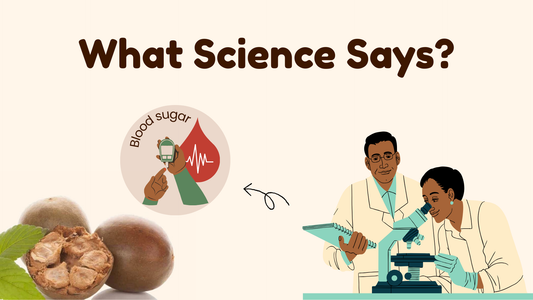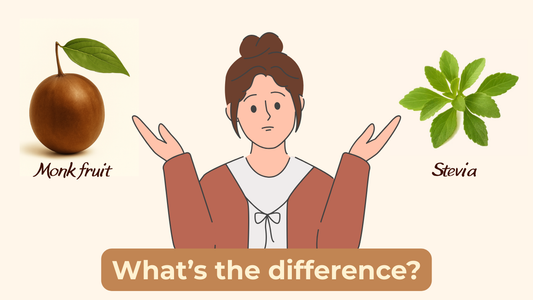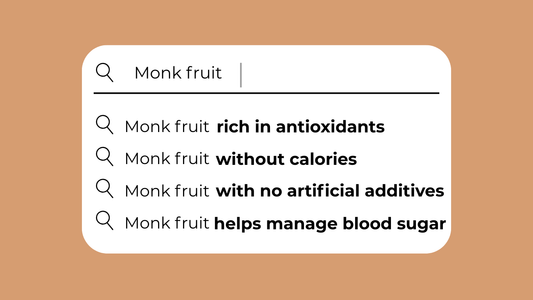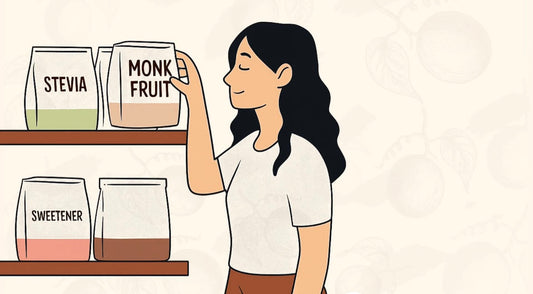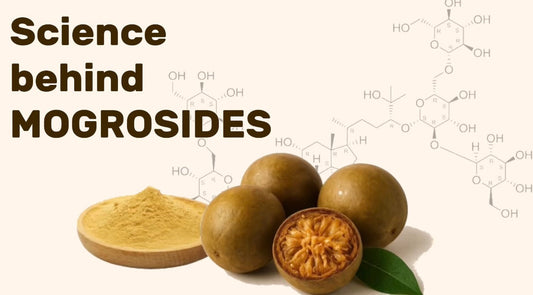Why This Story Matters
Every grain of sugar you see on your dining table has been through a journey - from cane fields to factories, from juice to crystal. But that journey comes with baggage: chemical refining, bleaching, nutrient loss, and the creation of a product that fuels diabetes, obesity, and inflammation.
Monk fruit sweetener’s story is completely different. It starts in the mountains, not in an industrial sugar mill. It’s made through a process that respects the fruit, extracts what’s naturally sweet, and delivers it in a form you can actually use in your kitchen.
If you’ve ever wondered, “Is monk fruit really natural? How exactly do they make it?” - here’s the full story.
Step 1: Growing Monk Fruit in the Mountains
Monk fruit (Luo Han Guo) grows in the subtropical mountains of Southern China and Northern Thailand.
-
The environment: warm climate, misty hillsides, nutrient-rich soil.
-
The farming: mostly traditional, with vines grown on trellises.
-
The history: Buddhist monks first cultivated it around the 13th century, using it for teas that soothed coughs, cooled the body, and promoted longevity.
👉 While sugarcane farming in India is industrial, water-intensive, and chemical-heavy, monk fruit farming is still small-scale, traditional, and sustainable.
Step 2: Harvesting at Peak Ripeness
The fruits are small (about the size of a lemon) and green when unripe. They’re harvested when they ripen into a golden-brown shade.
-
Timing is key: If picked too early, sweetness is low. Too late, and the fruit loses potency.
-
Farmers hand-pick fruits at the right stage.
-
Fresh monk fruit spoils quickly - it must be processed almost immediately.
For centuries, people dried the fruits whole, then brewed them in tea. But to create sweetener, the fresh fruit is taken straight to processing.
Step 3: Crushing the Fruit and Extracting Juice
This is where sugar and monk fruit part ways.
-
Sugarcane juice is rich in sucrose - which the body breaks into glucose + fructose (both raise blood sugar).
-
Monk fruit juice is rich in mogrosides - natural antioxidant compounds that taste incredibly sweet but are not sugars.
👉 Mogrosides are the “hero compounds.” They pass through your body without being absorbed as calories. That’s why monk fruit sweetener has zero calories and zero glycemic index.
Step 4: Filtering and Concentrating
The fresh juice is then:
-
Filtered to remove skin, pulp, and seeds.
-
Water is gently evaporated.
-
A concentrated monk fruit extract remains.
This extract is 150–200 times sweeter than sugar. You could sweeten an entire teapot with just a speck.
At this stage, monk fruit is powerful but not practical - which brings us to the next step.
Step 5: Blending Into a Usable Sweetener
If monk fruit extract is so amazing, why not sell it pure?
-
Problem: It’s too concentrated.
-
A pinch too much will ruin the taste.
-
It’s hard to measure or cook with.
👉 The solution is blending.
At EPRA Farms, we blend monk fruit extract with erythritol:
-
A natural sugar alcohol found in fruits like grapes and melons.
-
Zero calories, zero glycemic impact.
-
Adds bulk, so the blend looks, tastes, and measures like sugar.
This makes monk fruit sweetener practical for everyday life - spoon-for-spoon, it works like sugar in chai, coffee, halwa, or cookies.
Step 6: Testing, Certifications, and Safety
Every batch undergoes strict checks:
-
Purity tests → Ensuring no adulteration.
-
Safety tests → No contamination, no harmful residues.
-
Certifications → Monk fruit is FDA-approved (USA), EFSA-approved (Europe), and globally recognized as safe.
At EPRA, we go further - ensuring FSSAI approval, halal, kosher, gluten-free, and clean-label standards.
How Monk Fruit Differs from Sugar Processing
|
Stage |
Sugar (Cane/Beet) |
Monk Fruit Sweetener |
|
Farming |
Industrial, chemical-heavy |
Traditional, sustainable |
|
Refining |
Bleaching, chemicals, molasses removed |
Gentle water extraction |
|
Sweetness Source |
Sucrose (caloric) |
Mogrosides (non-caloric) |
|
Calories |
16 per teaspoon |
0 per teaspoon |
|
Glycemic Impact |
High |
Zero |
|
Health Impact |
Spikes, obesity, diabetes |
Safe, antioxidant-rich |
Why Blending Matters: Monk Fruit + Erythritol
This blend isn’t a compromise - it’s the secret to making monk fruit usable.
-
Pure monk fruit = too sweet, not kitchen-friendly.
-
Blended monk fruit = practical, measurable, family-friendly.
-
Erythritol is digested differently from sugar alcohols like sorbitol - it doesn’t cause bloating or spikes.
👉 This makes EPRA Monk Fruit Sweetener the closest natural match to sugar - without the harm.
Everyday Uses in the Indian Kitchen
Thanks to this process, monk fruit sweetener fits seamlessly into Indian life:
-
Tea & Coffee: Just spoon and stir - sweetness without calories.
-
Desserts: Works in kheer, payasam, halwa, ladoos.
-
Baking: Cakes, muffins, cookies come out perfectly.
-
Smoothies & Shakes: Sweetness without sugar overload.
-
Daily Cooking: Can be used in sauces, marinades, chutneys.
It’s not just a Western health trend - it’s something that works in our kitchens, our recipes, our traditions.
The Bigger Picture: Why This Matters for India
India is the diabetes capital of the world. One in every 10 Indians is diabetic or prediabetic. Our food culture is rich and sweet-heavy - chai, mithai, desserts, festive foods.
Sugar is deeply rooted, but it’s also deeply harmful.
Monk fruit isn’t about asking people to give up sweetness. It’s about giving India a new kind of sweetness - one that fits our culture without damaging our health.
Final Takeaway: From Fruit to Future
Monk fruit sweetener isn’t an artificial trick. It’s a fruit, processed simply, blended cleanly, and tested for safety.
-
Where sugar is stripped, monk fruit is preserved.
-
Where sugar harms, monk fruit protects.
-
Where sugar feels old and risky, monk fruit feels like the future of sweetness.
At EPRA Farms, we’re proud to be the first to bring this clean hero ingredient to India - so families can keep their sweetness, but lose the guilt.


